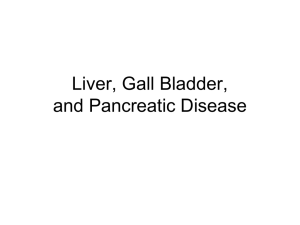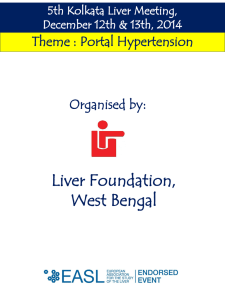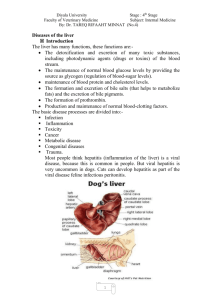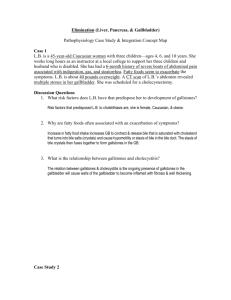67 Gastrointestinal and Hepatic Manifestations of Systemic Diseases Ellen C. Ebert
advertisement
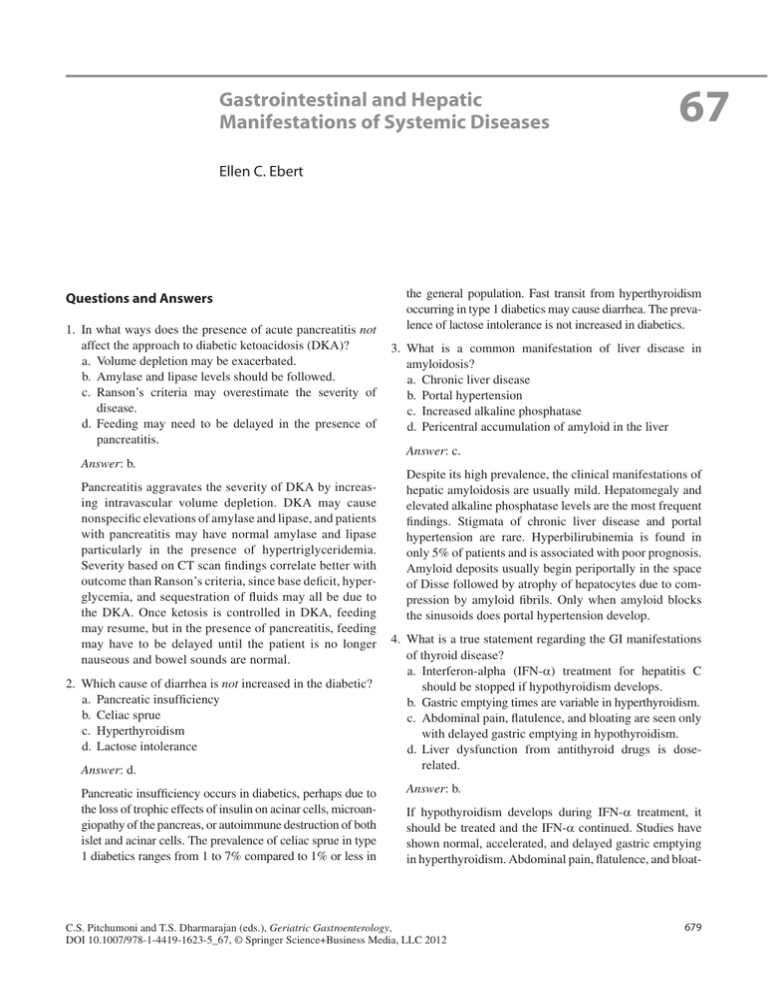
Gastrointestinal and Hepatic Manifestations of Systemic Diseases 67 Ellen C. Ebert Questions and Answers 1. In what ways does the presence of acute pancreatitis not affect the approach to diabetic ketoacidosis (DKA)? a. Volume depletion may be exacerbated. b. Amylase and lipase levels should be followed. c.Ranson’s criteria may overestimate the severity of disease. d.Feeding may need to be delayed in the presence of pancreatitis. Answer: b. Pancreatitis aggravates the severity of DKA by increasing intravascular volume depletion. DKA may cause nonspecific elevations of amylase and lipase, and patients with pancreatitis may have normal amylase and lipase particularly in the presence of hypertriglyceridemia. Severity based on CT scan findings correlate better with outcome than Ranson’s criteria, since base deficit, hyperglycemia, and sequestration of fluids may all be due to the DKA. Once ketosis is controlled in DKA, feeding may resume, but in the presence of pancreatitis, feeding may have to be delayed until the patient is no longer nauseous and bowel sounds are normal. 2. Which cause of diarrhea is not increased in the diabetic? a. Pancreatic insufficiency b. Celiac sprue c. Hyperthyroidism d. Lactose intolerance Answer: d. Pancreatic insufficiency occurs in diabetics, perhaps due to the loss of trophic effects of insulin on acinar cells, microangiopathy of the pancreas, or autoimmune destruction of both islet and acinar cells. The prevalence of celiac sprue in type 1 diabetics ranges from 1 to 7% compared to 1% or less in the general population. Fast transit from hyperthyroidism occurring in type 1 diabetics may cause diarrhea. The prevalence of lactose intolerance is not increased in diabetics. 3. What is a common manifestation of liver disease in amyloidosis? a. Chronic liver disease b. Portal hypertension c. Increased alkaline phosphatase d. Pericentral accumulation of amyloid in the liver Answer: c. Despite its high prevalence, the clinical manifestations of hepatic amyloidosis are usually mild. Hepatomegaly and elevated alkaline phosphatase levels are the most frequent findings. Stigmata of chronic liver disease and portal hypertension are rare. Hyperbilirubinemia is found in only 5% of patients and is associated with poor prognosis. Amyloid deposits usually begin periportally in the space of Disse followed by atrophy of hepatocytes due to compression by amyloid fibrils. Only when amyloid blocks the sinusoids does portal hypertension develop. 4. What is a true statement regarding the GI manifestations of thyroid disease? a.Interferon-alpha (IFN-a) treatment for hepatitis C should be stopped if hypothyroidism develops. b. Gastric emptying times are variable in hyperthyroidism. c.Abdominal pain, flatulence, and bloating are seen only with delayed gastric emptying in hypothyroidism. d.Liver dysfunction from antithyroid drugs is doserelated. Answer: b. If hypothyroidism develops during IFN-a treatment, it should be treated and the IFN-a continued. Studies have shown normal, accelerated, and delayed gastric emptying in hyperthyroidism. Abdominal pain, flatulence, and bloat- C.S. Pitchumoni and T.S. Dharmarajan (eds.), Geriatric Gastroenterology, DOI 10.1007/978-1-4419-1623-5_67, © Springer Science+Business Media, LLC 2012 679 680 ing may result from bacterial overgrowth in hypothyroidism. Since the liver dysfunction from antithyroid drugs is due to hypersensitivity, it may not be dose-related. 5. What is not a common characteristic of liver disease in sarcoidosis? a. Portal hypertension from liver dysfunction b. Lack of symptoms c. Lung involvement d. Hepatomegaly by CT scan Answer: a. Only a small proportion of patients develop portal hypertension, usually due to obstruction of portal flow by granulomas in the portal area (presinusoidal block) or to arteriovenous shunts that increase portal blood flow; cirrhosis as a cause is uncommon. As a result, esophageal varices can develop in the absence of cirrhosis. The symptoms of liver disease are infrequent with pruritus and abdominal pain being more common than jaundice. Lung is involved in 75% of patients with liver disease. Hepatomegaly is found in over half of the patients on CT scan and in all patients with portal hypertension. 6. What statement is true regarding the GI manifestations of scleroderma? a.Regular endoscopies are required in those with reflux to screen for malignancy. b.Esophageal manometric findings are pathognomonic of scleroderma esophagus. c.Diverticulitis is a common complication of diverticular disease in scleroderma. d.Incontinence may result from an abnormality of the internal anal sphincter (IAS). Answer: d. Whether esophageal cancer is increased in scleroderma ­compared to other patients with reflux is unclear. The low-amplitude peristalsis of the esophagus and lower esophageal sphincter (LES) pressure characteristic of E.C. Ebert scleroderma can also be seen in amyloidosis, diabetes, chronic alcoholism, moniliasis, severe reflux, and hypothyroidism. The characteristic wide-mouthed colonic diverticuli are not prone to developing diverticulitis. Since the IAS is composed of smooth muscle, it may be weak, leading to incontinence. 7. What is a characteristic of hypoxic liver injury (HLI)? a. Transaminase levels that decline within a week b. Hypodense lesions on CT scan c. Portal hypertension d. Triggered by hypotension alone Answer: b. Transaminases characteristically decline in a few days in HLI. Hypoechoic lesions on ultrasound and hypodense lesions on CT scan resolve completely with reversal of the initiating event. Portal hypertension and chronic liver disease may occur with cardiac cirrhosis but not with HLI. Typically, right-sided heart failure and low cardiac output are seen along with an initiating event such as arrhythmias that may cause transient hypotension. 8. What disorder does not manifest a definite increase in end-stage renal disease (ESRD)? a. Pancreatic disease on autopsy b. Nonocclusive mesenteric ischemia c. Ulcer disease d. Constipation Answer: c. Pancreatic disease at autopsy is common but not pancreatitis. The incidence of nonocclusive mesenteric ischemia particularly of the cecum and right colon is higher in hemodialysis patients. Ulcer disease is not increased. Constipation is common due to reduced physical activity and fiber intake; use of iron, calcium supplements, or phosphate binders; and presence of diabetes or cerebrovascular disease are additionally contributed.
